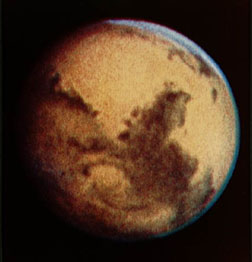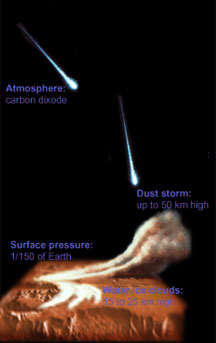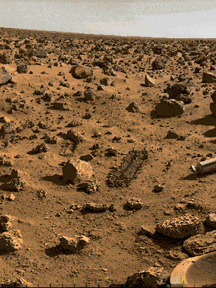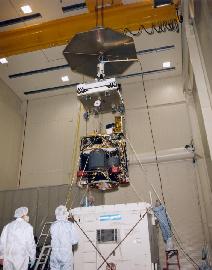Click on image for full size
Courtesy of NASA
Related links:
Discovery of Mars
Mars is much like Venus-- it's very bright and therefore easily spotted in the night sky. Because of this, we don't know who exactly discovered Mars. We do know it was named after the Roman god of war, because its reddish color reminded people of blood.
In 1659, Christian Huygens discovered a strange feature on the surface of the Red Planet. It was later called the Syrtis Major. Fear of Martian invasion has been in society ever since. In 1802, one scientist was so convinced there was life on Mars that he wanted to draw huge figures in the snow to signal the Martians!
In 1877, astronomer Giovanni Schiaparelli discovered what he believed to be several lines crossing one another. He claimed they were water canals made by intelligent creatures. His work spawned many science fiction books and movies, such as H.G. Wells' War of the Worlds. Eventually, we sent spacecraft to investigate the Red Planet.
In 1971, Mariner 9 visited Mars and sent back images of enormous volcanoes and vast canyons. It discovered Olympus Mons, now the most famous volcano not on Earth. This massive volcano could cover the state of Missouri, and reaches 15 miles above the surface! Mariner 9 also found evidence that water once flowed on Mars. However, there were no sightings of Schiaparelli's famous canals.
In 1975, two spacecraft named Viking I and II landed on Mars to study its surface. They analyzed the rocks and soil of the planet while providing us with information about its atmosphere and weather patterns. Even today we are exploring Mars. The Mars Global Surveyor made a detailed 3-dimensional map of the planet. Unfortunately, the loss of the Mars Climate Orbiter and the Mars Polar Lander has been a big setback in our research.
Although Mars was never really discovered, its moons were! In 1877, astronomer Asaph Hall spotted the two moons and named them Phobos, which means fear, and Deimos, which means panic. They were named after the mythical horses that drew the chariot of the Roman god, Mars.















